Table of Contents
Thinking about getting inked? Butterfly tattoos are a timeless choice, fluttering onto skin with their delicate beauty and rich symbolism. More than just pretty pictures, tattoo designs butterfly represent transformation, freedom, and the ever-changing nature of life. Whether you're drawn to their vibrant colors or the deeper meanings they carry, a butterfly tattoo can be a powerful statement. This article will guide you through the captivating world of butterfly tattoos. We'll explore the diverse meanings associated with these designs, from rebirth and hope to love and spirituality. You'll discover popular styles, variations, and placement ideas to help you find the perfect butterfly tattoo that resonates with your personal story. Plus, we'll offer tips on choosing the right artist and caring for your new ink, ensuring your butterfly tattoo remains a beautiful reminder of your journey for years to come. Get ready to spread your wings and dive in!
The Enduring Symbolism of Butterfly Tattoos
The Enduring Symbolism of Butterfly Tattoos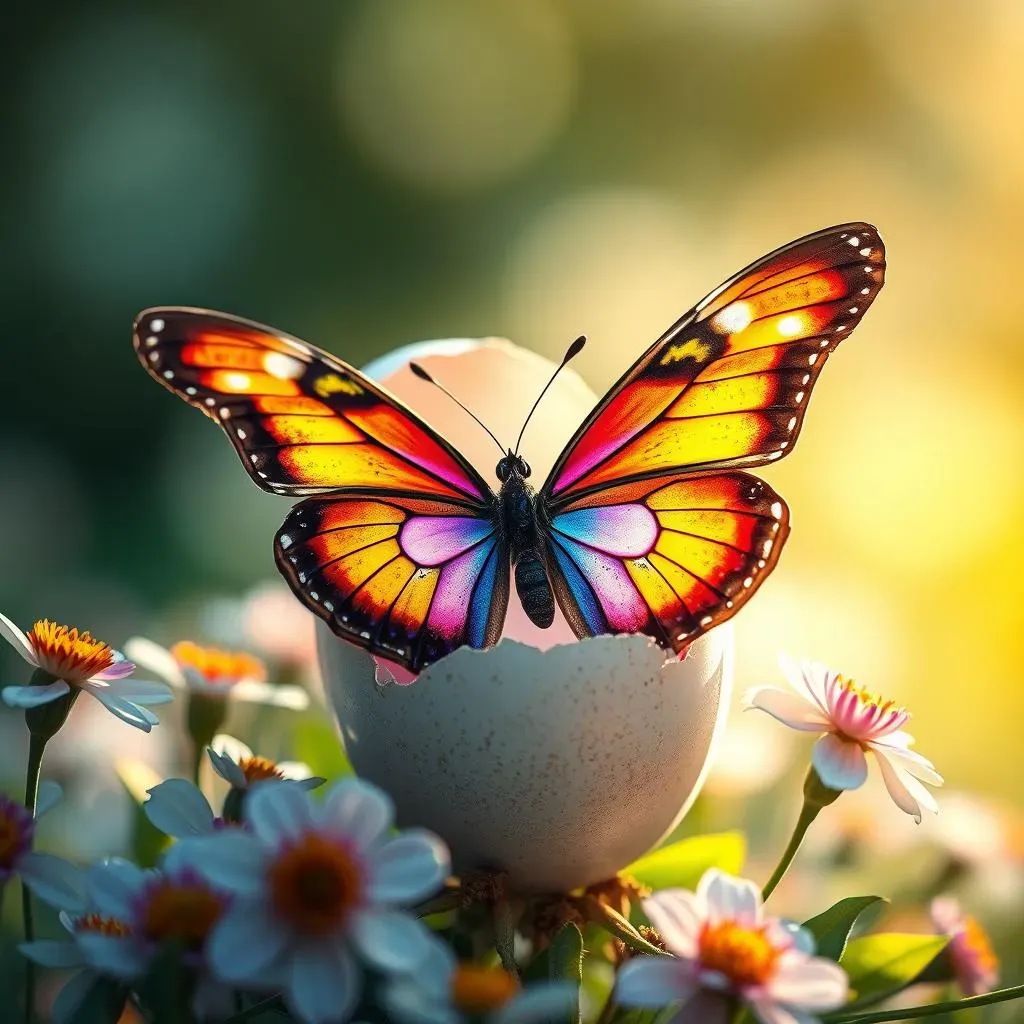
Transformation and Rebirth
Butterflies are the poster children for transformation, right? I mean, they start as caterpillars, munching on leaves, and then BAM! They retreat into a chrysalis and emerge as these stunning, winged creatures. This incredible metamorphosis makes butterfly tattoos a powerful symbol of personal growth, change, and rebirth. It's like saying, "I've been through some stuff, but I've come out stronger and more beautiful on the other side."
Think about it: if you've overcome a challenging period in your life, a butterfly tattoo can be a constant reminder of your resilience and ability to evolve. It’s a celebration of shedding your old skin and embracing a new chapter. That's why they are so special!
Freedom and Liberation
Ever watch a butterfly flit and flutter through a garden? There's a sense of effortless freedom in their movements. Butterfly tattoos often represent liberation from constraints, whether those constraints are physical, emotional, or mental. They can symbolize breaking free from toxic relationships, overcoming limiting beliefs, or simply embracing a more carefree and independent lifestyle.
For some, a butterfly tattoo is a declaration of independence, a visual representation of their journey towards self-discovery and autonomy. It’s about owning your life and choosing your own path, just like a butterfly charting its own course through the sky.
Love, Hope, and Spirituality
Beyond transformation and freedom, butterfly tattoos also carry deeper spiritual meanings. In some cultures, butterflies are seen as messengers from the spirit world, representing loved ones who have passed on. They can also symbolize hope, new beginnings, and the delicate beauty of life. The butterfly's association with love stems from its graceful movements and vibrant colors, often linked to feelings of joy, passion, and connection.
I once met a woman who got a butterfly tattoo after losing her mother. She told me it was a way to feel connected to her and to remember the love they shared. It was a beautiful and powerful tribute. Whether you see them as symbols of love, hope, or spiritual connection, butterfly tattoos offer a profound way to express your inner beliefs and values. They're like little reminders of what truly matters.
Symbol | Meaning |
|---|---|
Transformation | Personal growth, rebirth, change |
Freedom | Liberation, independence, autonomy |
Spirituality | Hope, connection to loved ones, inner peace |
Popular Butterfly Tattoo Designs and Their Variations
Popular Butterfly Tattoo Designs and Their Variations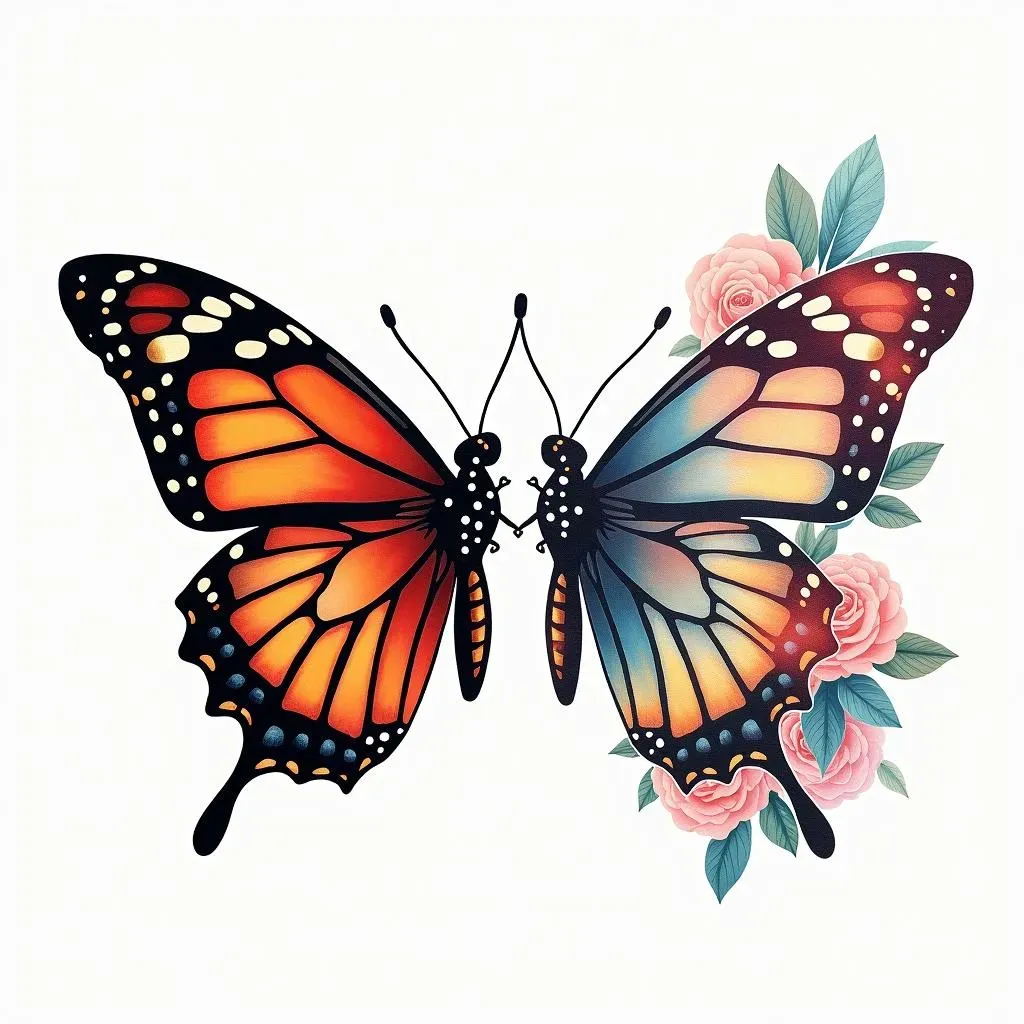
Traditional Butterfly Tattoos
When you think of butterfly tattoos, the traditional style is probably what pops into your head first. These designs usually feature bold outlines, vibrant colors, and a classic, almost vintage feel. Think Sailor Jerry-esque butterflies, but maybe a little less nautical and a lot more whimsical. They often incorporate roses, hearts, or banners with script, giving them a timeless appeal. These tattoos are all about making a statement, and the bold lines ensure they'll stand the test of time, both literally and figuratively.
I've seen some incredible traditional butterfly tattoos that look like they've jumped straight out of an old-school tattoo parlor. The colors are so saturated, and the lines are so clean. It's a style that really celebrates the artistry of tattooing itself. If you're into that classic, bold look, a traditional butterfly tattoo might be right up your alley.
Watercolor Butterfly Tattoos
On the opposite end of the spectrum, you have watercolor butterfly tattoos. These are all about soft, dreamy colors that blend seamlessly together, mimicking the look of a watercolor painting on skin. There are typically no harsh outlines, which gives the tattoo a delicate and ethereal quality. Watercolor tattoos are perfect for those who want a more subtle and artistic design. They’re like wearable art, and each one is unique due to the nature of the watercolor effect.
However, a heads-up: watercolor tattoos can fade faster than traditional tattoos because of the lack of defined outlines. It's super important to find an artist who specializes in this style and knows how to properly pack the color for longevity. Also, diligent aftercare is a must to keep those colors vibrant. But if you're willing to put in the extra effort, the result can be absolutely stunning. It's a way to get a tattoo that truly feels like a piece of fine art.
Design Style | Characteristics | Best For |
|---|---|---|
Traditional | Bold outlines, vibrant colors, classic imagery | Those who like a classic, timeless look |
Watercolor | Soft colors, blended effect, no harsh outlines | Those who want a subtle, artistic design |
Placement Ideas for Butterfly Tattoo Designs
Placement Ideas for Butterfly Tattoo Designs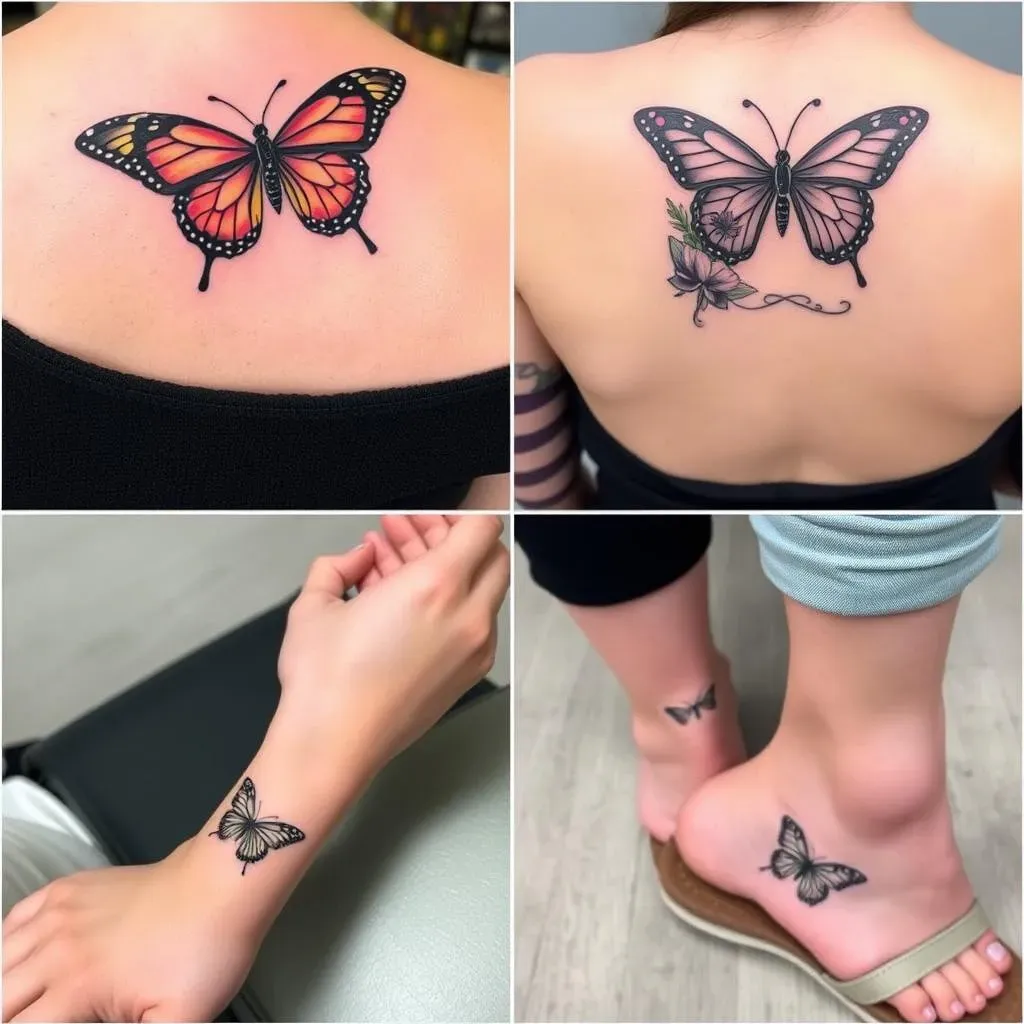
Shoulder and Back Butterfly Tattoos
The shoulder and back are prime real estate for butterfly tattoos, offering ample space for larger, more detailed designs. A butterfly stretching its wings across your shoulder blades can look incredibly striking, especially with vibrant colors and intricate patterns. The back provides an even bigger canvas, allowing for a whole swarm of butterflies or a larger, more elaborate composition with floral elements or other complementary imagery. These locations are great for showing off your ink, especially during the warmer months.
I've seen some amazing back pieces that tell a whole story with butterflies, incorporating elements of nature and personal symbolism. If you're thinking big and bold, the back is definitely the way to go. Plus, it's a relatively private area, so you can choose when and how you want to display your tattoo. Shoulders are a little more visible, which is perfect if you want to show off your butterfly with tank tops or off-the-shoulder tops.
Wrist and Ankle Butterfly Tattoos
For a more subtle and delicate look, the wrist and ankle are excellent choices for butterfly tattoos. A small, dainty butterfly on the wrist can be a sweet and understated reminder of personal growth or freedom. The ankle offers a similar effect, peeking out from sandals or shoes with a touch of whimsy. These placements are perfect for those who prefer a more minimalist style or want a tattoo that's easily concealed.
I have a friend who has a tiny butterfly on her wrist, and it's so cute! It's a simple design, but it's incredibly meaningful to her. She says it reminds her to stay grounded and appreciate the small joys in life. Ankle tattoos are also great because they're relatively low-pain compared to other areas. So, if you're a little squeamish about needles, the ankle might be a good starting point. Plus, you can easily cover it up with socks or pants if you need to.
Placement | Description | Pros | Cons |
|---|---|---|---|
Shoulder | Butterfly across the shoulder | Good visibility, ample space | Can be painful |
Back | Large design across the back | Large canvas, privacy | More painful, harder to see |
Wrist | Small, dainty butterfly | Subtle, easily concealed | Limited space, more visible fading |
Ankle | Small butterfly near the ankle bone | Subtle, relatively low pain | Limited space |
Choosing the Right Artist for Your Butterfly Tattoo
Choosing the Right Artist for Your Butterfly Tattoo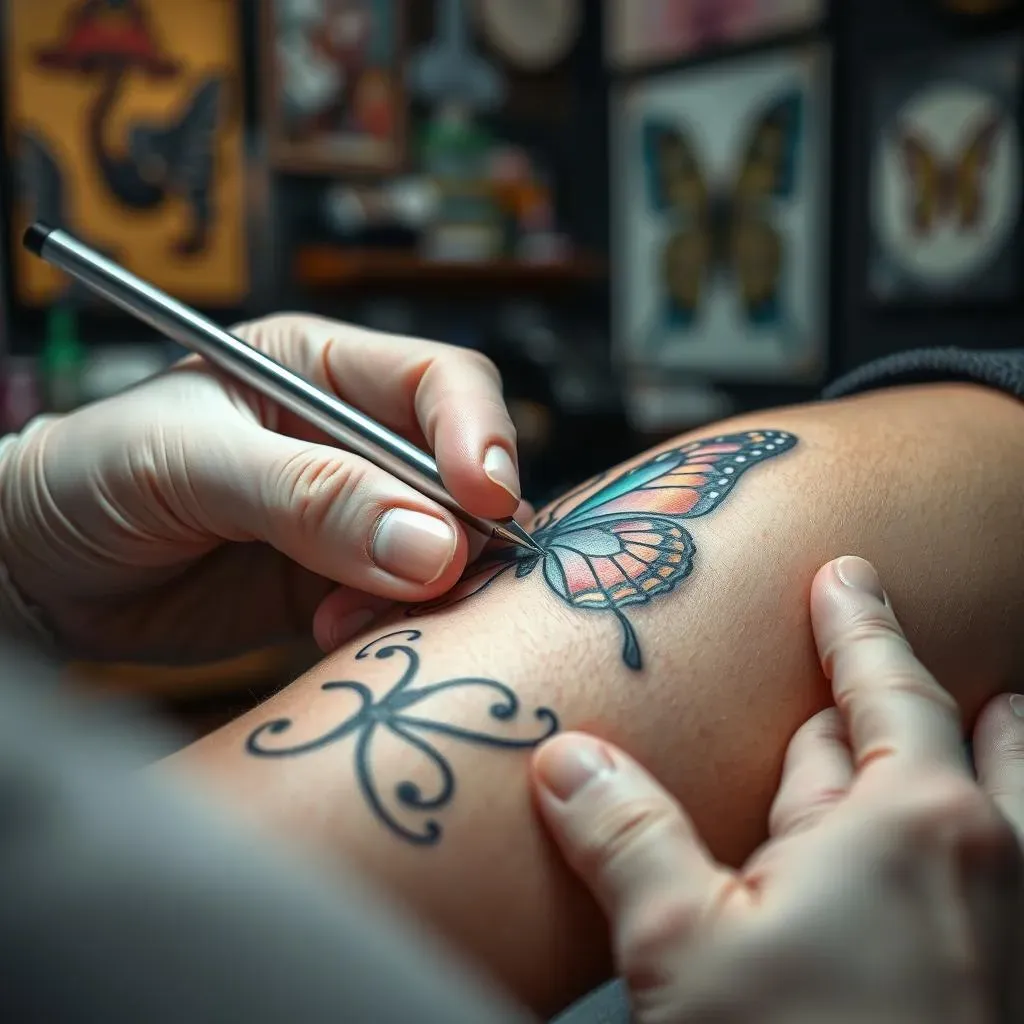
Portfolio Review: The Window to Their Soul (…of Tattooing)
so you've got the perfect butterfly design swirling in your head. Now comes the crucial part: finding the artist who can bring that vision to life. This isn't like picking a hairdresser based on a friend's recommendation. You need to do some serious digging and find someone whose style truly resonates with you. The first step? Stalk their portfolio. I mean, *thoroughly* review their work. Most artists have an online presence these days, whether it's on Instagram, their own website, or a studio page. Take your time and really scrutinize their previous tattoos. Are the lines clean and crisp? Is the shading smooth and consistent? Do their color choices pop, or do they look muddy and dull? Pay attention to the details, because that's what separates a good tattoo from a great one.
Don't just look for butterfly tattoos specifically (although that's a bonus!). Focus on the artist's overall style and technical skills. Can they execute the type of design you're envisioning? For example, if you want a delicate watercolor butterfly, make sure they have experience with that technique. If you're leaning towards a bold, traditional design, look for examples of their linework and color saturation. Trust me, a little research goes a long way in ensuring you end up with a tattoo you'll love for years to come.
Portfolio Aspect | What to Look For |
|---|---|
Linework | Clean, crisp, consistent lines |
Shading | Smooth transitions, no harsh gradients |
Color | Vibrant, saturated colors (if applicable) |
Style | Consistency with the style you want |
Specialization and Experience: Not All Artists Are Created Equal
Here's a little secret: not all tattoo artists are experts in every style. Some specialize in black and gray realism, while others excel at vibrant, new-school designs. And that's perfectly okay! The key is to find an artist whose specialization aligns with the type of butterfly tattoo you want. If you're dreaming of a hyper-realistic monarch butterfly, you'll want an artist with a strong background in realism and attention to detail. On the other hand, if you're after an abstract, geometric butterfly, look for someone who's comfortable working with those types of shapes and patterns.
Experience also matters, of course. A more experienced artist is likely to have a better understanding of how different inks heal, how to work with various skin tones, and how to create a tattoo that will stand the test of time. Don't be afraid to ask artists about their experience with specific styles or techniques. A good artist will be honest about their strengths and limitations. It's way better to find someone who's confident and skilled in the style you want than to settle for someone who's just "okay" at everything.
Consultation is Key: Vibe Check and Idea Exchange
Once you've narrowed down your list of potential artists, it's time to schedule a consultation. This is your chance to meet the artist in person (or via video call) and discuss your ideas in detail. Bring reference photos, sketches, and any other visual aids that can help them understand your vision. Don't be afraid to ask questions about their process, their preferred inks, and their aftercare recommendations. A good artist will be happy to answer your questions and offer their professional advice. Pay attention to how they communicate and whether they seem genuinely interested in your project. Do they listen to your ideas, or do they try to steer you towards something completely different? Do you feel comfortable and confident in their abilities? The consultation is just as much about assessing their skills as it is about making sure you vibe with them on a personal level. You're going to be spending a few hours (or more!) with this person, so it's important to choose someone you trust and feel comfortable around.
Caring for Your New Butterfly Tattoo: A Guide
Caring for Your New Butterfly Tattoo: A Guide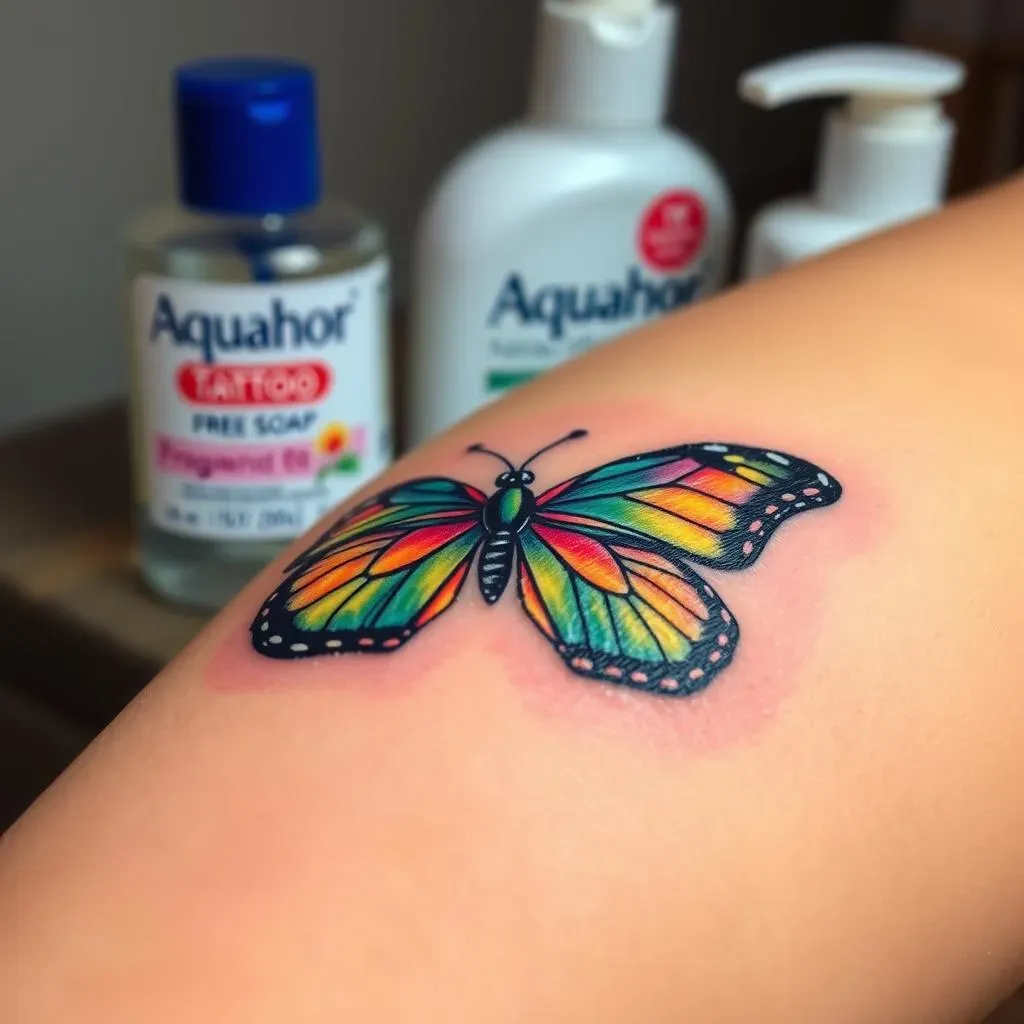
The First Few Hours: Listen to Your Artist!
Alright, you've got your gorgeous new butterfly tattoo! Now comes the not-so-glamorous part: aftercare. But trust me, following these steps is crucial for ensuring your tattoo heals properly and looks its best for years to come. The first few hours are the most important. Your artist will apply a bandage or protective film to your new tattoo. Leave it on for the amount of time they recommend, usually between 2-24 hours. This bandage protects the open wound from bacteria and other nasties that could cause an infection. Resist the urge to peek! I know it's tempting, but trust the process.
Once you remove the bandage, gently wash the tattoo with lukewarm water and a mild, fragrance-free soap. Avoid harsh soaps, exfoliants, or anything with alcohol, as these can irritate the skin. Pat the tattoo dry with a clean paper towel – don't rub! – and let it air dry for a few minutes before applying a thin layer of tattoo-specific aftercare ointment or a fragrance-free, hypoallergenic moisturizer. Aquaphor is a popular choice, but there are plenty of other great products out there. Just make sure it's not too thick or greasy, as this can trap moisture and prevent the tattoo from breathing. Less is more!
The Healing Process: Patience is a Virtue
The healing process typically takes 2-4 weeks, but it can vary depending on the size and location of your tattoo, as well as your individual healing rate. During this time, it's important to keep the tattoo clean and moisturized. Wash it gently twice a day and apply a thin layer of aftercare ointment or moisturizer as needed. Your tattoo will likely scab, flake, and itch – resist the urge to pick or scratch! Picking scabs can lead to infection and scarring, which can ruin your tattoo. Trust me, it's not worth it. Instead, gently pat the area to relieve the itch.
Also, avoid prolonged sun exposure, swimming, and soaking in baths or hot tubs during the healing process. Sunlight can fade the ink, and chlorine and bacteria in water can increase the risk of infection. Wear loose-fitting clothing to avoid rubbing and irritation. And most importantly, listen to your body! If you notice any signs of infection, such as excessive redness, swelling, pus, or fever, contact your artist or a medical professional immediately.
Stage | Duration | Care Instructions |
|---|---|---|
Initial Bandage | 2-24 hours | Leave bandage on as instructed by artist |
Washing & Moisturizing | 2-4 weeks | Wash gently twice daily, apply thin layer of ointment |
Healing | Varies | Avoid sun, swimming, picking scabs |
Long-Term Care: Keeping Your Butterfly Beautiful
Once your tattoo is fully healed, it's important to continue taking care of it to keep it looking its best. Sunscreen is your best friend! Always apply a high-SPF sunscreen to your tattoo before spending time in the sun. This will help prevent fading and keep the colors vibrant. Also, keep your skin moisturized. Dry skin can make your tattoo look dull and lifeless. A good daily moisturizer will keep your skin hydrated and your tattoo looking fresh. Avoid harsh chemicals and abrasive cleansers on your tattoo. These can irritate the skin and damage the ink.
And finally, consider getting touch-ups every few years to keep your tattoo looking its best. Ink can fade over time due to sun exposure, aging, and other factors. A touch-up can refresh the colors and lines, ensuring your butterfly tattoo remains a beautiful work of art for years to come. Think of it as a little maintenance to keep your masterpiece in tip-top shape!
Embrace Transformation: The Beauty of Butterfly Tattoo Designs
From their profound symbolism to their diverse artistic interpretations, butterfly tattoos offer a unique way to express personal growth, freedom, and the beauty of change. Whether you opt for a minimalist silhouette, a vibrant watercolor masterpiece, or a design that incorporates other meaningful elements, your butterfly tattoo will serve as a constant reminder of your own transformative journey. Remember to choose an artist whose style aligns with your vision and to care for your new ink diligently. With the right design and dedication, your butterfly tattoo will be a cherished piece of art that tells your story for years to come. So, go ahead, embrace the beauty and symbolism of the butterfly and let your spirit take flight.